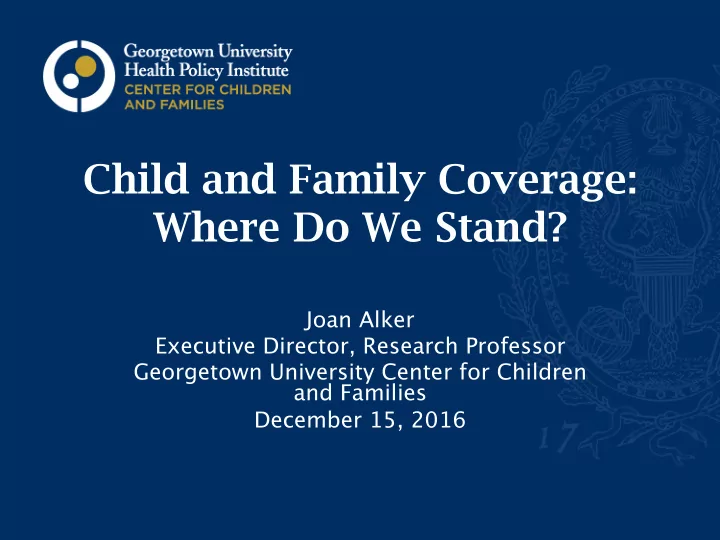

Child and Family Coverage: Where Do We Stand? Joan Alker Executive Director, Research Professor Georgetown University Center for Children and Families December 15, 2016
The Childr The Children’ en’s Uninsur s Uninsured Rate has ed Rate has Declined T Declined To Historic Low o Historic Low Source: J. Alker, A. Chester, “Children’s Health Coverage Rate Now at Historic High of 95 Percent,” 2 Georgetown University Center for Children and Families, October 2016.
Par Parent Coverage Has Impr ent Coverage Has Improved T oved Too oo 24% 23.3% 22.4% 22.0% 21.5% 22% 21.0% 20.8% 21.0% 20% 20.3% 20.2% 20.0% 19.7% 18% 18.7% Other Adults 16.4% Parents 16% 16.4% 14% 13.3% 12.9% 12% 10% 2008 2009 2010 2011 2012 2013 2014 2015 Source: Urban Institute tabulations of 2008-2015 National Health Interview Survey data Notes: Parents are defined as adults ages 19 to 64 living with a biological child, adoptive child, or 3 stepchild age 18 or under. Uninsured is at time of survey. All other adults age 19 to 64 are classified as childless.
The Public is Not Awar The Public is Not A ware of This Success e of This Success In the Last 5 Years, Do You Think the Number of Uninsured Children Has Increased, Decreased, or Stayed the Same? 22% Increased 1% Decreased 49% Don't Know/Refused Stayed the Same 28% Source: PerryUndem Poll. National Omnibus Survey October 7-9, 2016 4
Public Coverage for Childr Public Coverage for Children en Source: Source: “Child Enrollment in CHIP and Medicaid by State, FY 2015.” MACPAC. 5 “Health Insurance Marketplaces 2016 Open Enrollment Period: March Enrollment Report.” ASPE. March 11, 2016.
Childr Children’ en’s Upper Income Eligibility s Upper Income Eligibility 450% Highest 400% State Breakdown of State Eligibility 405% Eligibility 350% FPL # of 300% States Median State Eligibility < 200% 2 250% 255% 200% 200% – 250% 21 Lowest State Eligibility 150% 250% - 300% 9 175% 100% > 300% 19 50% 0% Source: 50-State Survey on Medicaid and CHIP , Kaiser Family 6 Foundation and Georgetown CCF
Medicaid and CHIP Cover 44% of Medicaid and CHIP Cover 44% of Childr Children Under Age Six en Under Age Six 5% Medicaid/CHIP 54% 44% Private Coverage Uninsured Source: “Medicaid’s Role for Young Children.” Georgetown University Center for Children and 7 Families, September 2016.
Rate of Uninsur Rate of Uninsured Childr ed Children by State, 2015 en by State, 2015 Source: J. Alker, A. Chester, “Children’s Health Coverage Rate Now at Historic High of 95 8 Percent,” Georgetown University Center for Children and Families, October 2016.
Medicaid and CHIP Structur Medicaid and CHIP Structure Medicaid CHIP • Pays 65% to 85% of costs; • Pays 50% to 83% of costs with a 23% point bump in 2016 • 50% of admin costs • Pays CHIP match for • Open-ended federal Financing admin costs, subject to funding to states for 10% cap eligible populations and services • Block grant with built in safety valves • Minimum standards for Program benefits (EPSDT) Fewer minimum standards Rules than Medicaid • Cost-sharing restrictions None - Can freeze or cap Coverage Guaranteed enrollment, if enrollment or require waiting eligible Guarantee periods 9
Medicaid and CHIP: Benefits Medicaid and CHIP: Benefits Medicaid Medicaid CHIP CHIP • Medicaid expansion: • Comprehensive services Medicaid benefit through Early Periodic package Screening Diagnostic • Separate program - and Treatment (EPSDT) based on Benchmark • All services necessary to plan that is closer to correct and ameliorate private coverage physical and mental • Secretary-approved health conditions coverage 10
Medicaid and CHIP: Eligibility Medicaid and CHIP: Eligibility CHIP Maximum Standar CHIP Maximum Standards ds Medicaid Minimum Standards Medicaid Minimum Standar ds • Children above Medicaid • Children 0-18 with income income levels at state option up to 133% FPL - 200% FPL upper limit, or • Infants born to women - 50 percentage points > Medicaid limit in place in June 1997 covered by Medicaid - Pre-ACA, states used income under pregnant women’s disregards and deductions to achieve higher income eligibility coverage for first year of thresholds; those levels are grandfathered as of enactment of life the ACA • Unborn children at state option 11
Medicaid is the Largest Sour Medicaid is the Largest Source of ce of Federal Funds for States Federal Funds for States Federal Fund Expenditures, FY 2015 All Other Programs 43.9% Medicaid 56.1% Medicaid All Other Programs $319 Billion $250 Billion Source: State Expenditure Report: Examining Fiscal 2014-2016 State Spending, National 12 Association of State Budget Officers (NASBO).
Substantial Federal Medicaid Cuts Substantial Federal Medicaid Cuts ar are Looming e Looming Price’s Plan to Cut Medicaid 41% o Rep. Price’s plan would eliminate the ($2.1 Trillion) guarantee of coverage and benefits (like EPSDT) � o In the plan’s tenth year (2026), funding for Medicaid would be 47% less than what it 59% is under current law. Overall Medicaid Spending Over 10 Years (2017-2026) Total: $5.1 Trillion Source: E. Park and M. Broaddus (personal communication, December 2016); E. Park, “Medicaid Block Grant Would Add Millions to Uninsured and Underinsured,” Center on Budget and Policy 13 Priorities (March 2016), available at http://www.cbpp.org/blog/medicaid-block-grant-would-add- millions-to-uninsured-and-underinsured.
Want to Lear ant to Learn Mor n More? e? • Visit our website ccf.georgetown.edu and sign up for our newsletter! • Follow us on Twitter: @GeorgetownCCF and @JoanAlker1 • Facebook: Georgetown University Center for Children and Families 14
Recommend
More recommend